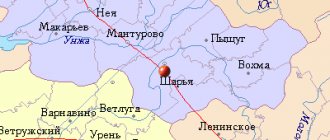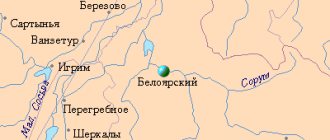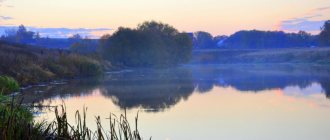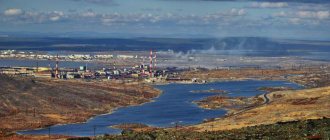Pages of history
THE BEGINNING of the construction of the energy giant in the 60s became a matter of national importance due to, as the energy industry puts it, “a shortage of electrical power in the center of the European part of Russia.” As usual, there were corresponding decisions of the party and government. In accordance with them, on August 14, 1962, the Ministry of Power Plant Construction made a decision on the construction of the Verkhne-Volzhskaya State District Power Plant (as Kostroma State District Power Plant was originally called).
But even earlier, an engineering and survey team of the Gorky branch of the All-Union State Design Institute “Teploproekt” appeared at the site of the proposed construction: geologists, hydrologists, biologists, surveyors, drillers, led by M. N. Zayakin (then N. S. Shakirov) and N. A. Nikolai. On the left bank of the Shachi, they first set up tarpaulin tents, and then panel houses. The pioneer base of prospectors was called the Village of Geologists. Later it became part of Volgorechensk.
Geologists took soil samples; hydrologists determined the speed and direction of the Volga flow for each season, measured every meter of the bottom; biologists studied the “life” of the aquatic area; surveyors were surveying the area.
“The summer of 1962 was rainy,” recalls M. F. Khlebnikov, surveyor of the engineering and survey team. “Wad boots didn’t help.” We were transported to the “points” on a sleigh attached to a caterpillar tractor. When they drilled a well in the place of the first chimney, they had to make a multi-layer log flooring so that the drilling rig would not be pulled into the swamp.
The general designer prepared technical documentation for the final power plant capacity of 4800 MW. The Council of Ministers of the USSR allowed the construction of only the first stage of 1200 MW (four power units of 300 MW each). The corresponding project was approved in 1967. The government approved the second stage project, also for 1,200 MW (four more power units of 300 MW each), in 1971.
However, the Kostroma State District Power Plant began to be built before the design assignment was approved - in 1963, according to drawings drawn up for priority work.
On June 22, 1963, Order No. 93 of the State Production Committee for Energy and Electrification was issued on organizing the directorate of the Kostroma State District Power Plant under construction, subordinating it to Kostromaenergo. The first director was A.D. Stukovnin. The staff consisted of five people: head of the production and technical department (later - deputy director for capital construction) B.V. Chudov, chief accountant R.F. Tikhonov, technical documentation engineer V.V. Fedorov, secretary-typist M.A. Komarova and two curators - V. A. Ivanov and N. V. Ilatovskaya.
The office of the directorate of the Kostroma State District Power Plant under construction is located in the village. Sidorovsky on the territory of a timber warehouse. The log five-walled building consisted of two rooms: one was occupied by the director; the other housed a staff of engineering and technical workers. B.V. Chudov says: “There was a lot of work: analysis and processing of all incoming technical documentation for the pioneer base, for access roads and railways. Lots of agreements. Financing was provided through Stroybank in Kostroma. We got there by train from Ivanovo to Kostroma, landing at the station. Furmanov or hitchhiking from the village of Sholokhovo, Krasnoselsky district (we walked to the village).
WHAT names did they try to give to the emerging village! In 1964, due to the absence of government bodies, the party bureau took the initiative and built the SU KGRES: on October 9, they sent a letter to the chairman of the Kostroma Industrial Regional Executive Committee A.I. Kurtsev: “The village still has no name. We suggest giving one of the recommended ones...” And then a list: Luchegorsk, Luch, Svetochegorsk, Luchezarny, Yasnogorsky, Energetik and even Svetlyachok. Who came up with the name “Volgorechensk”? There are many versions.
One of them was voiced in his memoirs by V.I. Panov. According to him, they whiled away a working evening with a heart-to-heart conversation. The winter wind whipped against the plank walls of the trailer, dusting the paths trampled by hundreds of feet with stinging snow. It was warm because of the crowds. They started singing: “Volga-river...”. And immediately someone exclaimed: “So this is what we can call our village - Volgorechensk!” The name of the one who said this is not etched in my memory. But I liked the name and remembered it.
On October 15, 1964, the executive committee of the regional (industrial) Council of Workers' Deputies, by its decision No. 561, registered “a settlement that arose during the construction of the Kostroma State District Power Plant in the territory of the Kostroma district of the Kostroma region, called Volgorechensk.”
In a letter sent to the Presidium of the Supreme Soviet of the RSFSR, the chairman of the regional executive committee writes: “The construction of the Kostroma State District Power Plant is being carried out in an area remote from the administrative centers and cut off from them by the Volga River and the Shacha River. The absence of a local government body has a negative impact on cultural and everyday services for builders...” The author of the letter requests from the higher government body staff for the future village Council of Workers’ Deputies in the amount of 8 units.
On November 1, 1964, an executive committee consisting of 5 people was created as a temporary governing body (until the elections of deputies to the village Council): N.S. Volkov (chairman), V. A. Egorov (deputy chairman), L. P. Baranova (secretary), A. V. Telnov, I. N. Simonov. The main responsibility of the members of the executive committee was civil registration. At the same time, preparations were made for elections to the village Council of Workers' Deputies, scheduled for March 1965. The first among the workers' deputies in the village government were N.S. Volkov, L.N. Sundukov, A.N. Kozlov, R.A. Valeev, I.A. Smirnov, V.P. Anisimov, G.N. Sazonova and others. The Village Council became subordinate to the Kostroma City Council of Workers' Deputies.
At the request of the village Council, in April 1965, by Decree of the Presidium of the Supreme Soviet of the RSFSR, the village was given the name Volgorechensk.
In 1964, the first newborns appeared in the village. On August 3, a daughter, Svetlana, was born to Alexander Ivanovich and Tatyana Gennadievna Zyatkov. The place of registration of the girl was the Krasnoselsky registry office, where on September 11, 1964 the corresponding entry was made under No. 59. The village of Volzhsky was recorded as the place of birth.
On October 8, 1964, a son, Igor, was born to Konstantin Ivanovich and Alexandra Anatolyevna Kosterin. The fact of birth was registered by the Krasnoselsky registry office on November 13 under No. 71 (the village of Kostroma State District Power Plant is designated as the place of birth of the baby).
The first newborn registered by the executive committee of the Volgorechensky Village Council was Sergei Zhukov, born on January 9, 1965 to Alexander Ivanovich and Nina Alekseevna Zhukov (actual record No. 1 of January 20, 1965). Activity record No. 2 dated February 3, 1965 certifies the birth of the girl Oksana on January 18, 1965 to Vladimir Nikolaevich and Zinaida Antonovna Podolsky.
In the 60s, twins appeared in the families of the Zhurkins, Rublevs, Golubevs, Gulyaevs, Kalinins, Zhigalovs, Talamanovs and Filippovs. At first, the Vladimir section of the Mosenergostroy trust (head of the section A.I. Ryzhenkov) acted as the general contractor. Then the volumes were transferred to the newly organized trust “Tsentrenergostroy”. On the initiative of the chief engineer of the trust, I. B. Kopelyan, a construction management of the Kostroma State District Power Plant was organized. On August 30, 1963, the corresponding order of the State Production Committee for Energy and Electrification of the USSR No. 52/a was issued.
The office of SU KGRES is located in Privolzhsk.
Social sphere and education[ | ]
In 2012, there were 12 educational institutions in Volgorechensk. [ source not specified 349 days
]
There is a Volgorechensk city hospital.
The city has centers - cultural, youth, social services, a children's art school (choreography and music), a children's art school (sculpture, arts and crafts, painting and graphics). In August 2008, the stadium was put into operation.
In 1999, 2002, 2003, Volgorechensk received the title of the most comfortable settlement in the Kostroma region. [ source not specified 349 days
]
There are seven kindergartens in the city, two secondary schools and a comprehensive lyceum named after. N.P. Vorobyova, industrial technical school. [ source not specified 349 days
]
Since 1999, the annual Interregional Festival of Patriotic Song “Russia's Faithful Sons” has been held. [ source not specified 349 days
]
In 2001, a Local History Center was opened in the city. [ source not specified 349 days
]
Volgorechensk today
More than forty years have passed since the founding of our city. Volgorechensk is a young city, its history is not as ancient as that of other cities in the Kostroma region, but it has already left its mark both in the life of the region and in the life of the entire country.
Our city currently produces about twenty percent of all industrial production in the region; Volgorechensk has the highest standard of living in the region.
We have something to be proud of: industrial enterprises, which are the basis of the city’s economy, have adapted to new conditions. Thanks to the well-coordinated work of the labor collectives of the Kostromskaya GRES branch of OJSC OGK-3, OJSC Gazpromtrubinvest, CJSC Volga-SFAT and other enterprises, growth in volumes of both industrial production and the consumer market is ensured.
All social institutions operate stably and develop dynamically. Social protection of the city population is one of the main activities of local governments.
We, Volgorechensk residents, love our city and strive for its development. The joint efforts of all residents, their work makes it possible to move on and jointly do everything for the benefit and prosperity of our city and its residents!
Population[ | ]
| Population | ||||||||
| 1970[7] | 1979[8] | 1989[9] | 2001[10] | 2002[11] | 2003[10] | 2005[10] | 2007[10] | 2008[12] |
| 7828 | ↗13 253 | ↗15 966 | ↗19 000 | ↘18 164 | ↗18 200 | ↘17 900 | ↘17 700 | ↘17 565 |
| 2009[13] | 2010[14] | 2012[15] | 2013[16] | 2014[17] | 2015[18] | 2016[19] | 2017[20] | 2018[21] |
| ↗17 632 | ↘17 104 | ↘17 032 | ↘16 868 | ↘16 768 | ↗16 804 | ↘16 701 | ↘16 653 | ↘16 539 |
| 2019[22] | 2020[23] | 2021[1] | ||||||
| ↘16 375 | ↘16 276 | ↘16 111 | ||||||
As of January 1, 2022, in terms of population, the city was in 749th place out of 1,116[24]cities of the Russian Federation[25].
Attractions[ | ]
At the entrance to Volgorechensk, St. Tikhon's Cathedral, built in 1996-2006, rises on a gentle hill.
In 1979, a sculpture of Prometheus, 19 meters high, was installed in the central square of the city. It was made in the antique style and became the first sculpture of a naked person in the USSR. Authors: sculptor A. D. Kazachok and architects V. Azarov and G. Mironov. [ source not specified 349 days
]
In the center of the city there is a Monument of Glory in honor of soldiers, home front workers, and children of war. Restored in 2015.
In 2014, on Pervostroiteley Square, for the city’s anniversary, a black cube with a capsule containing a message to future generations was opened. The cube contains photographs of the city and brief facts from its history.
The gun is a howitzer from the Great Patriotic War, installed near the military registration and enlistment office.
A fragment of the 19th century road (the so-called “Ekaterininka”) leading to the Makaryevskaya Fair.
The chapel of worship, illuminated in memory of the soldiers who died in Afghanistan and Chechnya. [ source not specified 349 days
]
Notes[ | ]
- ↑ 12
The permanent population of the Russian Federation by municipalities as of January 1, 2022 (Russian). Retrieved April 27, 2022. Archived May 2, 2022. - Law of the Kostroma Region of February 9, 2007 N 112-4-ZKO “On the administrative-territorial structure of the Kostroma Region”
- Charter of the municipal formation of the urban district of the city of Volgorechensk, Kostroma region
- Pospelov, 2008, p. 144.
- Law of the Kostroma Region of December 30, 2004 N 237-ZKO “On establishing the boundaries of municipalities in the Kostroma Region and granting them status”
- Resolution of the Kostroma Regional Duma dated July 2, 2015 No. 2630 “On the abolition of a settlement on the territory of the urban district of the city of Volgorechensk, Kostroma Region”
- All-Union Population Census of 1970 The size of the urban population of the RSFSR, its territorial units, urban settlements and urban areas by gender. (Russian). Demoscope Weekly. Access date: September 25, 2013. Archived April 28, 2013.
- All-Union Population Census of 1979 The size of the urban population of the RSFSR, its territorial units, urban settlements and urban areas by gender. (Russian). Demoscope Weekly. Access date: September 25, 2013. Archived April 28, 2013.
- All-Union population census of 1989. Urban population (undefined)
. Archived from the original on August 22, 2011. - ↑ 1234
People's encyclopedia "My City". Volgorechensk - All-Russian population census 2002. Volume. 1, table 4. Population of Russia, federal districts, constituent entities of the Russian Federation, districts, urban settlements, rural settlements - regional centers and rural settlements with a population of 3 thousand or more (unspecified)
. Archived from the original on February 3, 2012. - Resolution of the administration of the Kostroma region dated June 24, 2008 No. 184-A “On approval of the Register of settlements of the Kostroma region” (unspecified)
. Access date: February 22, 2015. Archived February 22, 2015. - The size of the permanent population of the Russian Federation by cities, urban-type settlements and regions as of January 1, 2009 (unspecified)
. Retrieved January 2, 2014. Archived January 2, 2014. - Population census 2010. Population of Russia, federal districts, constituent entities of the Russian Federation, city districts, municipal districts, urban and rural settlements (Russian). Federal State Statistics Service. Access date: February 9, 2013. Archived April 28, 2013.
- Population of the Russian Federation by municipalities. Table 35. Estimated resident population as of January 1, 2012 (unspecified)
. Retrieved May 31, 2014. Archived May 31, 2014. - Population of the Russian Federation by municipalities as of January 1, 2013. - M.: Federal State Statistics Service Rosstat, 2013. - 528 p. (Table 33. Population of urban districts, municipal districts, urban and rural settlements, urban settlements, rural settlements) (undefined)
. Retrieved November 16, 2013. Archived November 16, 2013. - Table 33. Population of the Russian Federation by municipalities as of January 1, 2014 (unspecified)
. Access date: August 2, 2014. Archived August 2, 2014. - Population of the Russian Federation by municipalities as of January 1, 2015 (unspecified)
. Access date: August 6, 2015. Archived August 6, 2015. - Population of the Russian Federation by municipalities as of January 1, 2016 (Russian) (October 5, 2018). Retrieved May 15, 2022. Archived May 8, 2022.
- Population of the Russian Federation by municipalities as of January 1, 2022 (Russian) (July 31, 2017). Retrieved July 31, 2022. Archived July 31, 2022.
- Population of the Russian Federation by municipalities as of January 1, 2022 (Russian). Retrieved July 25, 2018. Archived July 26, 2022.
- Population of the Russian Federation by municipalities as of January 1, 2022 (Russian). Retrieved July 31, 2019. Archived May 2, 2022.
- Population of the Russian Federation by municipalities as of January 1, 2022 (Russian). Date accessed: October 17, 2022. Archived October 17, 2022.
- taking into account the cities of Crimea
- https://rosstat.gov.ru/storage/mediabank/bul_Chislen_nasel_MO-01-01-2021.rar Population of the Russian Federation by municipalities as of January 1, 2022 (1.85 Mb, 07/30/2021)






